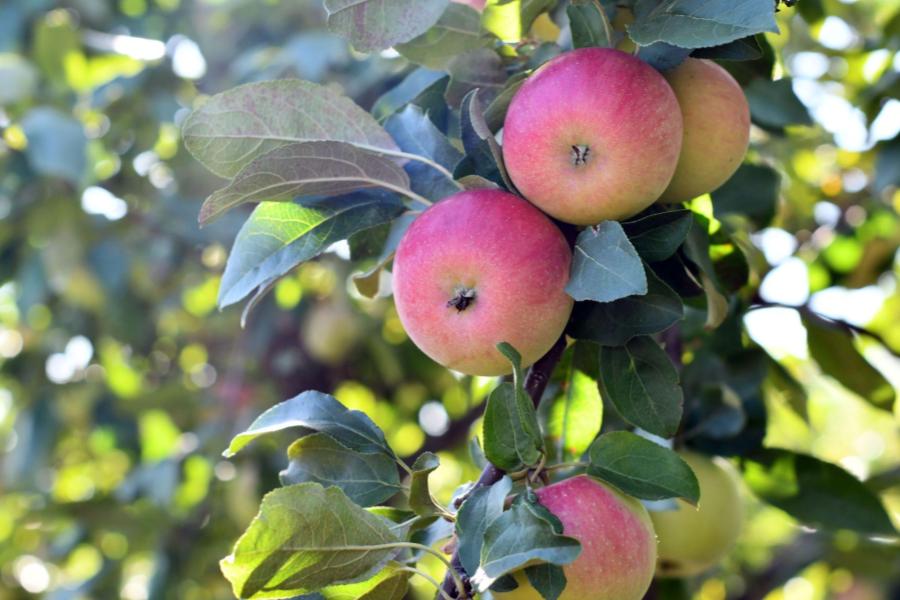
MINNEAPOLIS/ST. PAUL (04/04/2022) — Ancestry tests aren’t just for people or pets anymore. Thanks to DNA-based tracking, researchers at the University of Minnesota have finally traced the family tree of the Honeycrisp apple — one of the top ten varieties produced in the United States.
Recently published in HortScience, the findings are the result of sifting through thousands of DNA markers to unwind the pedigrees of many of the U of M’s best apple cultivars. Researchers were able to follow the roots back to European ancestral varieties and the first days of the U of M apple breeding program, which began in 1908 at the Horticultural Research Center. Since then, the program has introduced 28 cultivars, including Honeycrisp, and those sold under the Zestar!, SweeTango, First Kiss and Rave trademarks.
In the program’s early years, researchers collected seeds from orchards around the state in hopes of finding new cultivars that could not only survive, but thrive in Minnesota’s harsh winters. Even though controlled breeding began in 1916, non-standardized practices and fragmentary documentation left many ancestries up for interpretation. Now, with readily available DNA markers from around the world, the chance to solve the Honeycrisp ancestry mystery was within reach.
Former University graduate student and postdoctoral researcher Nicholas Howard, now an apple breeder in the Netherlands, first developed ancestry tracking techniques using DNA markers to determine the true parents of Honeycrisp as part of his dissertation research. Through an exhaustive, collaborative effort with University apple breeders Jack Tillman, David Bedford and Professor Jim Luby, Howard attempted a Herculean task — documenting the pedigree of all 28 University apple cultivars.
He enlisted numerous national and international collaborators to assemble a database of DNA fingerprints for over 6,000 apple cultivars based on over 10,000 Single Nucleotide Polymorphism (SNP) markers. Additionally, he tapped Ana Poets and Kevin Silverstein of the Minnesota Supercomputing Institute to develop custom software that could help uncover genetic relationships between cultivars by tracking pieces of DNA shared by relatives through multiple ancestral generations.
“A large collaborative database effort, combined with new genetic techniques, allowed us to identify the specific parents, grandparents and even more distant ancestors of U of M cultivars,” Howard said. “Based on these analyses we could confirm, correct or complete the parentage of 16 of the 22 cultivars introduced between 1920 and 1991.”
The researchers found:
- There were two pervasive founding ancestors in Honeycrisp’s family tree.
- ‘Duchess of Oldenburg’ (a Russian cultivar introduced to Minnesota in the late 19th century) was an ancestor of overwhelming importance, appearing in the pedigrees of 27 out of 28 University cultivars.
- ‘Reinette Franche,’ a French cultivar that appears not only in Honeycrisp’s family tree (as well as several other University cultivars) but also that of many historically important and commercially relevant cultivars, such as Gala and Golden Delicious.
The next step for the researchers is to explore the family tree even further, connecting thousands of cultivars across the globe, as well as identifying genomic contributions from ‘Duchess of Oldenburg’ and ‘Reinette Franche’ to highlight regions to target for future selection.
“Extended pedigrees will be very useful to breeders in determining future crosses,” Luby said. “The more we know about their ancestry, the better we can predict the inheritance of desirable traits based on that DNA-confirmed ancestry — which provides a useful feature for nurseries and apple growers when promoting their products.”
This research was partially supported by the Minnesota Agricultural Experiment Station with funding from the USDA National Institute of Food and Agriculture (NIFA).
-30-
About the College of Food, Agricultural and Natural Resource Sciences
The University of Minnesota’s College of Food, Agricultural and Natural Resource Sciences (CFANS) strives to inspire minds, nourish people, and sustainably enhance the natural environment. CFANS has a legacy of innovation, bringing discoveries to life through science and educating the next generation of leaders. Every day, students, faculty, and researchers use science to address the grand challenges of the world today and in the future. CFANS offers an unparalleled expanse of experiential learning opportunities for students and the community, with 12 academic departments, 10 research and outreach centers across the state, the Minnesota Landscape Arboretum, the Bell Museum of Natural History, and dozens of interdisciplinary centers.
- Categories:
- Agriculture and Environment





